 Set forth below is the fifty-fifth “Texas Shout” column. It first appeared in the October 1994 issue of the West Coast Rag, now known as The Syncopated Times. The following note was added when the column was reprinted in the late 90s.
Set forth below is the fifty-fifth “Texas Shout” column. It first appeared in the October 1994 issue of the West Coast Rag, now known as The Syncopated Times. The following note was added when the column was reprinted in the late 90s.
Note: Because the text has not been updated, I would like to make a few observations regarding the “hat” point discussed therein. Since the phenomenal success on the festival circuit of the excellent but relatively short-lived Uncle Yoke‘s Black Dogs, I have seen a number of post-Yoke combos on the scene dressed in similar “swamp” attire, including the hats. Also, some of the currently popular small-band swing/jump units captivating the swing-dance crowd sport headgear.
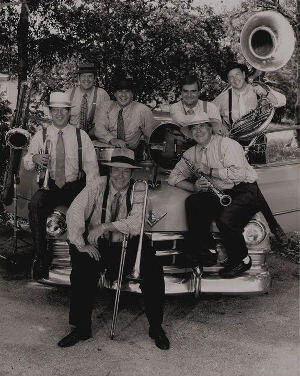
I have never seen or heard a word of comment, pro or con, regarding the chapeaus of these bands (most of which play little, if any, Dixieland). If it’s O.K. for these popular groups to wear hats, why do we have to put up with all the moaning and groaning whenever a Dixieland musician goes on stage with something on his/her head? Aren’t we long overdue to give this so-called “funny-hat Dixieland” cliche a rest?
Also relevant to the following discussion is the invention in recent years of the term “okom” (sometimes printed “OKOM”), short for “our kind of music.” It hardly needs to be said that the increased deployment of this acronym for an empty phrase, probably designed to avoid wrangling among devotees of older-style jazz over names like “Dixieland,” “trad” and the like, presents a serious obstacle to meaningful discussion thereof.
You cannot use “okom” unless you are certain that the person you are addressing knows precisely what you mean by the term. In that case, it makes little difference which word you choose.
However, if your listener needs any further guidance, you will not be able to give it to him without using “Dixieland,” “traditional,” “swing,” “Chicago style,” “mainstream” or one of the other labels that “okom” was apparently created to replace. So why go to all the trouble to conjure up some new, impossibly vague, category of music? Let’s do the job right, agree once and for all on what the established terms mean, and go on from there.
If you read these pages regularly, or much else that discusses older-style jazz, you’ll run across a number of terms of art. They will be used freely on the assumption that readers know what these terms mean. Examples include “Dixieland,” “uptown New Orleans,” “Chicago style,” etc.
Unfortunately, while these terms enjoy common usage, you will rarely find anyone setting down precise musical definitions thereof. As a result, there is a great deal of miscommunication and misunderstanding regarding our music. Someone will use such a word with the idea of making a certain point but various listeners/readers, because of the lack of common definitions, will receive different messages.
I first noticed this phenomenon as a youth when, having discovered Dixieland jazz and ragtime, and having no one in my hometown to explain them to me, I paid close attention to LP liner notes and to the volumes on the jazz shelf of the public library. I soon discovered that much of what was said therein not only didn’t square with other sources, but also didn’t square with what I was hearing on the records.
Take the word “Dixieland.” Many people who like older-style jazz have a knee-jerk reaction against that word. Initially, I tended to side with them.
However, over the years, I came to realize that, for better or for worse, the most widely recognized, most accessible term for describing pre-swing jazz is “Dixieland.” When I used it with the general public, everyone knew what I was talking about. It helped my Red Lion Jazz Band get gigs to say that we played “Dixieland.”
Popular culture does not always bestow names on its elements that are the ones their devotees would have selected. No one who thinks jazz is an art form can be very happy with the fact, considering the origins of the word, that it is called “jazz.” But, like it or not, nothing can be done about “jazz” at this late date.
“Dixieland” is the same way. Jazz that uses the conventions and vocabulary employed by jazzmen prior to the innovations that came in with swing are playing “Dixieland.” It is a broad umbrella term that includes seven distinct Dixieland styles, such as hot dance, Chicago, etc.
By the way, most people I’ve talked to who claim to hate the term “Dixieland” are unable to give me any well-thought-out reasons for disliking the word. If I ask them to tell me what “Dixieland” means, they usually start off discussing musicians who wear striped vests or funny hats.
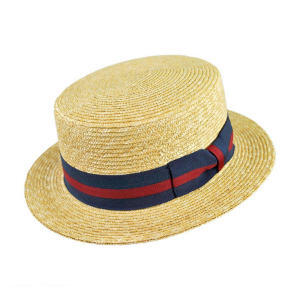 I’ll say right now that anyone who needs to know what a band is wearing in order to identify the music that it’s playing is someone who doesn’t know what he’s talking about. Further, if “Dixieland” bands wear funny hats, then there must not be any “Dixieland” bands any more; I’ve been around the scene for some time, and I can’t think of a single band these days that regularly wears hats at all, much less funny ones.
I’ll say right now that anyone who needs to know what a band is wearing in order to identify the music that it’s playing is someone who doesn’t know what he’s talking about. Further, if “Dixieland” bands wear funny hats, then there must not be any “Dixieland” bands any more; I’ve been around the scene for some time, and I can’t think of a single band these days that regularly wears hats at all, much less funny ones.
(The wonderful St. Louis Ragtimers, being a ragtime band and not a Dixieland band, don’t count, although I think their hats fit their rollicking onstage personality perfectly. What about the pith helmets sometimes worn by Don Neely’s Royal Society Jazz Orchestra? Would anyone be foolish enough to say that, when RSJO wears the costume using the pith helmets they’re playing “Dixieland,” but when they play the same chart in another uniform they’re playing some other kind of music?)
I don’t want to rehash the term “Dixieland,” because I covered it in my very first “Texas Shout” (see the November-December 1989 WCR). However, to give you an idea of the type of miscommunication I’m talking about, I’ll share a brief portion of a letter I received not long ago.
The writer claimed to be a regular reader of this column, although he attributed some opinions to me that are the exact opposite of those I’ve frequently taken herein from time to time. Either I don’t express myself clearly, or he isn’t paying attention. Anyway, his rather contentious epistle said, in part:
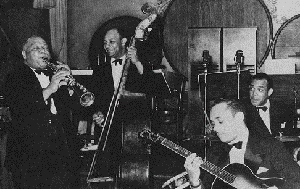
“… Jimmie Noone‘s group didn’t play ‘dixieland’ as we know it. They used an alto sax lead by Doc Poston; no trumpet, no trombone. But they sure enough played hot jazz.
“Similarly, my favorite recording – the one I play when I’m in the dumps and ready to quit the music – features Sidney Bechet and Muggsy Spanier with Wellman Braud on bass and Carmen Mastren on guitar. That’s all. Dixieland? Hardly. …”
Those comments prompt me to make the following point very clear all over again: The style of jazz played by a musician is determined by one thing and one thing only – the musical conventions and musical vocabulary employed during the performance. If those conventions and vocabulary do not use any elements introduced by swing and later jazz styles, then the performance is, in the lexicon used in this column since its inception, a Dixieland performance.
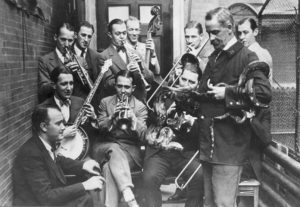
Anyone who thinks he can tell what style of jazz a band plays simply by knowing its instrumentation, without listening to it, needs to go back to Square One and start relearning our music. Of course you can play Dixieland without a trumpet, or without a trumpet and trombone, or without a clarinet, or with two trombones, or … .
As it turned out, my correspondent and I weren’t all that far apart in the essentials. His letter goes on to say, “Hot jazz is what we ought to be talking about here.” I couldn’t agree more, but that term is not precise enough. Swing when properly played is hot jazz – hot as blazes – so is bop.
We need a title for our music that is less inclusive than “hot jazz.” Like it or not, I haven’t found a better one than “Dixieland.”
Among the most common terms that older-style jazzmen use to describe their music is “traditional jazz.” After much thought, I have decided that this term no longer has a useful meaning in the older-style jazz community. In fact, I think that it is starting to become a divisive term that causes more heat than light.
I haven’t found any good use for “traditional” that isn’t served better by some other term that is more descriptive, less ambiguous, and less emotional. As a result, I try not to use it anymore.
I’d like to see the Dixieland community also start to downplay the word “traditional.” I’m going to use the rest of today’s column to explain how I came to that position.
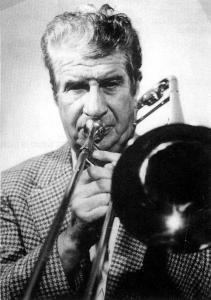 It was a long journey for me because, as I understand it, “traditional jazz” was coined by Turk Murphy, my all-time favorite musician and one of my earliest musical idols. When I was getting started in Dixieland, Turk could do no wrong.
It was a long journey for me because, as I understand it, “traditional jazz” was coined by Turk Murphy, my all-time favorite musician and one of my earliest musical idols. When I was getting started in Dixieland, Turk could do no wrong.
Turk’s style of Dixieland was one that he helped create as the trombonist for Lu Watters’ Yerba Buena Jazz Band. I suppose that Turk intended “traditional jazz” to be the descriptive name for that style.
However, as I said before, the public doesn’t always bestow on us the nicknames we prefer. Ever since I’ve followed our music, the branch of Dixieland played by Watters and Murphy has always been referred to as “San Francisco style” or “West Coast revival style.” The jazz community never accepted “traditional” as being limited to the jazz of Watters, Murphy and their disciples.
However, the term didn’t go away. That’s because “traditional” is a word that has a highly charged emotional connotation. Like “classic,” the word “traditional” suggests something that is time-honored, that has the approval of the ages, that has long and respectable roots.
Thus, everyone wants to be able to claim that the jazz he likes is “traditional.” For example, the earliest type of “modern” jazz, the style of bop played by Dizzy Gillespie and Charlie Parker in the early forties, is now a half-century old and sounds rather conservative when compared to some of the anarchic music (I almost said “noise”) appearing in the jazz bins in record stores. I’ve met early bop-style musicians who told me with a straight face that they play “traditional jazz.”
Moreover, the term “traditional,” in my view, has too often tended to exacerbate the kind of divisiveness in the Dixieland community that keeps us from acting together in our own best interests. There are those who believe that, if the kind of jazz they like is “traditional” – that is, has the legitimacy and authenticity of being based on long-established principles – then the jazz they don’t like must somehow be suspect. So they waste time discussing whether this band or that band is or is not “traditional,” as if that conclusion reveals anything about a combo’s musical merits.
Take for example, the excellent festival staged each August at Santa Rosa, one which has a reputation among festivalgoers of being a “traditional” festival. After the 1993 event, a really first-rate affair (it was one of those rare occasions when Nancy and I had a chance to hear at least a few tunes by every band on the bill), one of the directors had to endure a lengthy harangue from a fan about whether one of the featured groups was “traditional.” If it played good Dixieland, who the devil cares? (Believe it or not, the combo in question included former Murphy musicians, so one would think that such a band would be “traditional” if anything was.)
Another Santa Rosa official had to deal with a fan who vociferously asserted that a different band, one that plays top-drawer Chicago style, was not “traditional.” That particular complaint – that Chicago style is not “traditional” – is one I hear from time to time. It finally made me decide that the term “traditional” is doing the Dixieland community more harm than good.
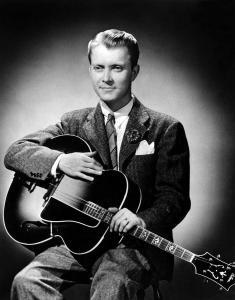
If “traditional” is supposed to describe jazz that has the legitimacy of having been grounded in the jazz age, let’s face it, Chicago style is not only traditional, but it also has a better claim to being traditional than two of the so-called “traditional” styles. Chicago style was actually played in the twenties, for Heaven’s sake, while West Coast revival didn’t come along until the forties and British trad was not heard before the fifties.
I can understand that, because Chicago is the only Dixieland style that is primarily solo-oriented, it might be useful to have a generally accepted shorthand term to distinguish Chicago style from the other six styles. I try to use “non-Chicago,” an expression that leaves no doubt as to what is meant.
Still, “non-Chicago” may sound a bit technical, or maybe a bit negative. A suitable alternative word to refer collectively to the six non-Chicago styles would call them “revivalist” styles. After all, when the Dixieland revival started in the forties, Chicago was the only Dixieland style that didn’t need reviving. It was still being played commercially at a fairly visible level. Thus, the other six styles are “revivalist” styles, a term which, in today’s scene, I believe is less emotionally charged than “traditional.”
While we’re on more neutral-sounding terminology, let’s return to the people who hate the word “Dixieland.” As I said, I think you’re shooting yourself in the foot by abandoning this widely understood word, but if you can’t say “Dixieland” without gritting your teeth, why not say “early jazz” instead? Because Dixieland is the earliest form of jazz, you’re not likely to be misunderstood by anyone with a smattering of knowledge about our music.
Are the points made above mere ivory-tower academia of no useful purpose? If you think Dixieland jazz is little more than a suitable background for dancing or for consuming a couple of beers, maybe so.
However, if we think our music is a legitimate art form, one that’s worthy of attention for its own sake, one that can touch deep emotions in its listeners, one that can send echoes through the decades to stir our passions, one that is capable of generating new and meaningful expressions, than it’s high time we began behaving accordingly. One way we can do so is to develop, as have other art forms (painting, literature, classical music, etc.), a commonly accepted, clearly defined vocabulary that will provide the basis for intelligent analysis and discussion of Dixieland. At least for the present, I favor leaving “traditional” out of it.
 Want to read ahead? Buy the book!
Want to read ahead? Buy the book!
The full run of “Texas Shout” has been collected into a lavishly illustrated trade paperback entitled Texas Shout: How Dixieland Jazz Works. This book is available @ $20.00 plus $2.95 shipping from Tex Wyndham, On request, Tex will autograph the book and add a personalized note (be sure to tell him to whom the note should be addressed).
Tex Wyndham’s 3 CD Guide to Dixieland with music and commentary is available for $20 plus $2.95 shipping. The separate CD, A History of Ragtime: Tex Wyndham Live At Santa Rosa, is available for $13.00 plus $2.00 shipping. On request, Tex will autograph the inner sleeve and add a personalized note (be sure to tell him to whom the note should be addressed).
Send payment to Tex Wyndham, P.O. Box 831, Mendenhall, PA 19357, Phone (610) 388-6330.
Note: All links, pictures, videos or graphics accompanying the Shouts were added at the discretion of the Syncopated Times editorial staff. They did not accompany the original columns and do not necessarily reflect the opinion of Tex Wyndham.
From roughly 1970-2010, Tex Wyndham was: (1) one of the best-known revivalist Dixieland jazz musicians in the US, as cornetist, pianist and bandleader, (2) one of the best-known ragtime pianists in the US, and (3) one of the most respected critics in the US of Dixieland jazz, ragtime, and related music. He is the only person about whom all three of those statements can be made.


















